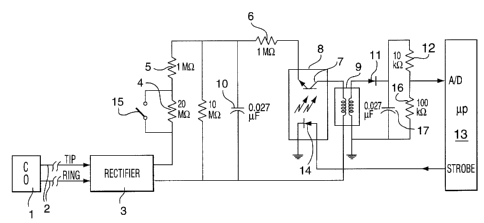Note: Descriptions are shown in the official language in which they were submitted.
~i~~~i~2
-- 1
A CIRCUIT FOR SENSING TELEPHONE LINE CONDITIONS
BACKGROUND OF THE IVVENTI0~1
1. Field of the Invention
The present invention relates to telephone sets in
general, and in particular to a circuit in a telephone
set for sensing the condition of a telephone line to
indicate, for example, whether another telephone or
other device on the line, or one of a number of lines,
is off-hook. Other conditions of a line may also be
sensed, such as "Message Waiting".
2. Prior Art of the Invention
United States patent 4,647,723 granted March 3, 1987 to
K.R. Voorhies discloses a solid state circuit designed
to be incorporated into a telephone terminal instrument
to prow de a W sual indication at that instrument that a
i
telephone line to which the instrument is connected is
already in use by another telephone instrument.
2
SUMMARY OF THE INVENTION
The object of the present invention is to provide a line
condition sensing circuit suitable for microcomputer
controlled telephone sets and the like.
The circuit of the present invention provides electrical
isolation between the telephone set it is incorporated
in and the telephone line it is monitoring; this
provides electrical isolation between different lines
connected to the same telephone set.
In addition to sensing that another telephone set or
device is using the line it is connected to, the circuit
may also be used to trip an answering machine, to log
calls as answered in a call display telephone, to
automatically drop a held call, to indicate
disconnection of the telephone cord, or to indicate a
"message waiting" signal on the monitored line.
Accordingly, the present invention provides a circuit
for sensing telephone line conditions, comprising: high
impedance termination means across the telephone line;
i
means for accumulating charge through said high
impedance termination means; and electrical isolator
means intermediate said means for accumulating charge
3
and voltage detecting means.
BRIEF DESCRIPTION OF THE DRAWINGS
The preferred embodiment of the present invention will
now be described in conjunction with the annexed drawing
figure, which is a circuit and black schematic for use
in a multi-line telephone set.
DETAILED DESCRIPTION OF THE PREFERRED EMBODIMENT
Referring now to the drawing figure, a central office
(CO) 1 is connected via telephone line 2 to voltage
rectifier 3, the output of which is connected through
high impedance resistor 4, resistor S and resistor 6 to
phototransistor 7 in optical coupler 8 (also known as
optical insulator), the other terminal of which is
connected to one end of the primary winding of
electrical isolator (a pulse transformer) 9, the other
end of the primary winding completing the circuit by
being connected to the remaining terminal of the
rectifier 3, to which is also connected one terminal of
charge accumulating capacitor 10, the other terminal of
i
which is connected to the phototransistor end of the
resistor 5. This is the "CO side" of the circuit of the
present invention, which CO side is electrically
_ 4
isolated from the telephone set side by means of the
electrical isolating pulse transformer 9.
The secondary winding of the transformer 9, is connected
via rectifier diode 11 and resistor 12 to the A/D
(analog-to-digital) input of a micro-corputer 13 in the
telephone set. A capacitor 14 is connected between the
cathode of the diode 11 and the other terminal of the
secondary winding of the transfor::ler 9. The
microcomputer 13 "strobes" light emitting diode 14 in
the optical computer 8 when required, thereby
discharging the capacitor 10 via the resistor 6 through
the primary winding of the transformer 9. This side of
the circuit shown is the "local side".
In operation; when hook-switch contact 15 (across the
resistor 4) is open (that is in the off-hook condition),
the diode 11 ensures that the voltage at the A/D input
of the microprocessor 13 is always above ground
reference. Resistor 12 and 16 bleed capacitor 17, so
that its voltage follows the voltage across the
telephone line 2. Since the line 2 "sees" a very high
impedance of approximately 21M ohm across, it is
unaffected, and several such impedances may be across
the same line in parallel without violating the on-hook
impedance specifications of the telephone company.
2~~~5~2
_ 5
Also, in this condition the high voltage dividing ratio
permits voltage sensing up to 120 volts. (Thus enabling
the microprocessor 13 to recognise a "message waiting"
voltage on the telephone line 2).
In an off-hook condition of the telephone set the switch
15 is closed. The impedance then seen by the line 2 is
approximately 1M ohm. Voltages up to approximately 12V
can be measured. The lower ratio of the voltage divider
yields better resolution for the low voltages present
while off-hook.
Timing control of the circuit is provided by the
microprocessor 13. The microprocessor 13, having an
analog to digital convertor, uses it to measure the
voltage developed on the local capacitor 17. The
microprocessor 13 uses the voltage measurements to
indicate that the extension is in use, and so forth.
The microprocessor 13 uses a slower strobe or sample
rate for on-hook conditions than it does for off-hook
conditions. This is done in order to minimize the risk
of violating the on-hook impedance specifications. The
i
on-hook sample period is 160 ms. The off-hook sample
rate is 16 ms.
213~5~~
6
The microprocessor 13 operates (strobes) the LED 14
whenever a sample is required. The optically coupled
transistor 7 switches the charge from the capacitor 10
through the pulse transformer 9 to the capacitor 17.
The microprocessor 13 then measures the voltage on the
capacitor 17 within a certain time limit to guarantee a
certain precision of measurement as required.
